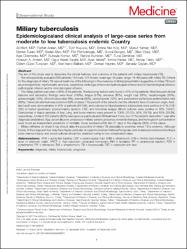| dc.contributor.author | Mert, Ali | |
| dc.contributor.author | Arslan, Ferhat | |
| dc.contributor.author | Kuyucu Yılmaz, Tülin | |
| dc.contributor.author | Koç, Emine Nur | |
| dc.contributor.author | Yılmaz, Mesut | |
| dc.contributor.author | Turan, Demet | |
| dc.contributor.author | Altın, Sedat | |
| dc.contributor.author | Pehlivanoğlu, Filiz | |
| dc.contributor.author | Şengöz, Gönül | |
| dc.contributor.author | Yıldız, Dilek | |
| dc.contributor.author | Dökmetaş, İlyas | |
| dc.contributor.author | Kömür, Süheyla | |
| dc.contributor.author | Kurtaran, Behice | |
| dc.contributor.author | Demirdal, Tuna | |
| dc.contributor.author | Erdem, Hüseyin Aytaç | |
| dc.contributor.author | Sipah, Oğuz Reşat | |
| dc.contributor.author | Batırel, Ayşe | |
| dc.contributor.author | Parlak, Emine | |
| dc.contributor.author | Tekin, Recep | |
| dc.contributor.author | Tunçcan, Özlem Güzel | |
| dc.contributor.author | Balkan, İlker İnanç | |
| dc.contributor.author | Hayran, Osman | |
| dc.contributor.author | Ceylan, Bahadır | |
| dc.date.accessioned | 2020-08-13T10:38:48Z | |
| dc.date.available | 2020-08-13T10:38:48Z | |
| dc.date.issued | 2017 | en_US |
| dc.identifier.citation | Mert, A., Arslan, F., Kuyucu Yılmaz, T., Koç, E. N., Yılmaz, M., Turan, D. ... Ceylan, B. (2017). Miliary tuberculosis epidemiologicaland clinical analysis of large-case series from moderate to low tuberculosis endemic country. Medicine, 96(5). https://dx.doi.org/10.1097/MD.0000000000005875 | en_US |
| dc.identifier.issn | 0025-7974 | |
| dc.identifier.issn | 1536-5964 | |
| dc.identifier.uri | https://dx.doi.org/10.1097/MD.0000000000005875 | |
| dc.identifier.uri | https://hdl.handle.net/20.500.12511/5722 | |
| dc.description.abstract | The aim of this study was to determine the clinical features, and outcome of the patients with miliary tuberculosis (TB). We retrospectively evaluated 263 patients (142 male, 121 female, mean age: 44 years, range: 16–89 years) with miliary TB. Criteria for the diagnosis of miliary TB were at least one of the followings in the presence of clinical presentation suggestive of miliary TB such as prolonged fever, night sweats, anorexia, weight loss: radiologic criterion and pathological criterion and/or microbiological criterion; pathological criterion and/or microbiological criterion. The miliary pattern was seen in 88% of the patients. Predisposing factors were found in 41% of the patients. Most frequent clinical features and laboratory findings were fever (100%), fatigue (91%), anorexia (85%), weight loss (66%), hepatomegaly (20%), splenomegaly (19%), choroid tubercules (8%), anemia (86%), pancytopenia (12%), and accelerated erythrocyte sedimentation rate (89%). Tuberculin skin test was positive in 29% of cases. Fifty percent of the patients met the criteria for fever of unknown origin. Acidfast bacilli were demonstrated in 41% of patients (81/195), and cultures for Mycobacterium tuberculosis were positive in 51% (148/ 292) of tested specimens (predominantly sputum, CSF, and bronchial lavage). Blood cultures were positive in 20% (19/97). Granulomas in tissue samples of liver, lung, and bone marrow were present in 100% (21/21), 95% (18/19), and 82% (23/28), respectively. A total of 223 patients (85%) were given a quadruple anti-TB treatment. Forty-four (17%) patients died within 1 year after diagnosis established. Age, serum albumin, presence of military pattern, presence of mental changes, and hemoglobin concentration were found as independent predictors of mortality. Fever resolved within first 21 days in the majority (90%) of the cases. Miliary infiltrates on chest X-ray should raise the possibility of miliary TB especially in countries where TB is endemic. Although biopsy of the lungs and liver may have higher yield rate of organ involvement histopathologicaly, less invasive procedures including a bone marrow biopsy and blood cultures should be preferred owing to low complication rates. | en_US |
| dc.language.iso | eng | en_US |
| dc.publisher | Lippincott Williams and Wilkins | en_US |
| dc.rights | info:eu-repo/semantics/openAccess | en_US |
| dc.rights | Attribution-NoDerivatives 4.0 International | * |
| dc.rights.uri | https://creativecommons.org/licenses/by-nd/4.0/ | * |
| dc.subject | Diagnosis | en_US |
| dc.subject | Miliary Tuberculosis | en_US |
| dc.subject | Prognosis | en_US |
| dc.title | Miliary tuberculosis epidemiologicaland clinical analysis of large-case series from moderate to low tuberculosis endemic country | en_US |
| dc.type | article | en_US |
| dc.relation.ispartof | Medicine | en_US |
| dc.department | İstanbul Medipol Üniversitesi, Tıp Fakültesi, Dahili Tıp Bilimleri Bölümü, İç Hastalıkları Ana Bilim Dalı | en_US |
| dc.department | İstanbul Medipol Üniversitesi, Tıp Fakültesi, Dahili Tıp Bilimleri Bölümü, Enfeksiyon Hastalıkları ve Klinik Mikrobiyoloji Ana Bilim Dalı | en_US |
| dc.department | İstanbul Medipol Üniversitesi, Tıp Fakültesi, Dahili Tıp Bilimleri Bölümü, Halk Sağlığı Ana Bilim Dalı | en_US |
| dc.authorid | 0000-0001-8945-2385 | en_US |
| dc.authorid | 0000-0001-8022-7325 | en_US |
| dc.authorid | 0000-0002-9994-5033 | en_US |
| dc.authorid | 0000-0001-9658-7560 | en_US |
| dc.identifier.volume | 96 | en_US |
| dc.identifier.issue | 5 | en_US |
| dc.relation.publicationcategory | Makale - Uluslararası Hakemli Dergi - Kurum Öğretim Elemanı | en_US |
| dc.identifier.doi | 10.1097/MD.0000000000005875 | en_US |
| dc.identifier.wosquality | Q3 | en_US |
| dc.identifier.scopusquality | Q2 | en_US |




















